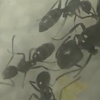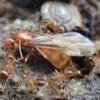So I went outside and I was sooo glad to find the first Citronella colony hole in the ground that I have ever found. And it is october in new jersey which is where I live. Also there were drones all alongside the massive citronella hole in the ground. Like they were prepping to fly off for a nuptial flight with other queens. And today was a decently nice day, almost somewhat hot. But not that hot. But anyway I am saying this because alot of october where I live has been cold, and multiple species are hibernating. So I looked up on the internet citronella ants, and there isn;t too much information about them, so basicaly I want to ask to see if anyone else knows. Do citronella ants work and have nuptial flights during october. Because there was scouts all around the nest looking for food far and near, there were tons and TONS of drones on the floor, Also I also want to know do they build sattelite nests? Cause there was a second big hole near the other one. Like 9 inches away.. I mean it could just lead to the same nest. But there were also drones and workers in that one too. Thanks!
- Formiculture.com
- Forums
- Gallery
- Members
- Member Map
- Chat

















